Reviews of film ephemera, including such things as educational films, industrial films, military and propaganda films, tv commercials, movie trailers, shorts, experimental films, and movies made for non-mainstream audiences.

The Burglar’s Slide for Life (film #42 on Edison Film Archive). [Category: Early Film & TV]
Ever have one of those days? You’re burgling a nice apartment in a high-rise tenement when the owners catch you and send their dog after you. You manage to escape out the winder and cleverly use a pulley to slide down all the clotheslines, but it turns out the dog is trained to do the same thing! Then once you reach the ground, the damn dog won’t let you drop! Finally, he goes away and you make it over a fence, but just when you have a chance to catch your breath at the top, the damn dog returns and pulls you down. Then the housewives come at you with their brooms and, well, let’s just say this was not a stellar day in the annals of burgledom. This is an amusing early film with a clever premise. A 1905 Edison film.Ratings: Camp/Humor Value: ****. Weirdness: ****. Historical Interest: ****. Overall Rating: ****.
Command Performance excerpts (film #4 on Disc #1 of Pearl Harbor: Before and After DVD (Triton Multimedia, 2001). Also, film #11 on World War II Remembered (Diamond Entertainment, 1995)). [Category: Military & Propaganda]
More excerpts from the "Command Performance" radio show, featuring Dorothy Lamour, Bob Hope, June Allyson, Gloria DeHaven, Jerry Colona, and Ethel Smith. This is pretty standard "Hollywood entertains the troops" stuff, but then they blindside you with a really weird musical short featuring singing cows animated Clutch Cargo-style doing a jazzed-up version of "Git Along Little Dogie". This segment is not to be missed. Bob Hope winds things up by singing "Thanks from America" to the tune of "Thanks for the Memories."Ratings: Camp/Humor Value: ***. Weirdness: ***** (4 are for the singing cows segment). Historical Interest: ****. Overall Rating: **** (an extra star was added for the singing cows).
Aunt Jemima Frozen Waffles (film #17 in the Daws Butler’s Cereal Commercials section of TVParty). [Category: Commercial]
Do you remember Wallace the Waffle Whiffer, the repetitive thief of Professor Goody's Aunt Jemima Waffles? I bet not. But once you hear his annoying "Waffle, Waffle, Waffle", it will all come rushing back to you. (OK, I admit I lifted this straight from my review of Cartoons Celing Commercials, Vol. 1. But what else can you say about the Waffle Whiffer, except that he’s one of the most annoying advertising characters of all time?)Ratings: Camp/Humor Value: ***. Weirdness: ***. Historical Interest: ****. Annoyance Factor: *****. Overall Rating: ****.
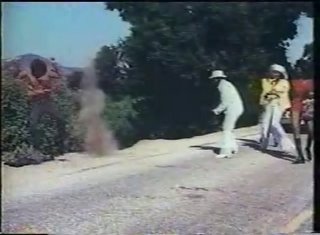
Dolemite Trailer (film #9 in the Blaxploitation section of Bedazzled. Also, film #9 in the Film section of Bedazzled. Also, film #9 in the Trailers section of Bedazzled. Also, film #9 in the Video section of Bedazzled). [Category: Sleaze & Outsider]
Another fun blaxploitation trailer, courtesy of Bedazzled. It’s narrated by the main character, a hard-shootin’, hard-lovin’ black dude dressed to the nines. Nothing real surprising here, but it’s done with style and energy, and it’s over the top, so it’s fun to watch.Ratings: Camp/Humor Value: ****. Weirdness: ****. Historical Interest: *****. Soul Quotient: *****. Overall Rating: ****.
Felix the Cat and the Goose That Laid the Golden Egg (film #9 on Felix the Cat DVD (Delta Entertainment, 2004). Also, film #1 on Film Chest Vintage Cartoons). [Category: Hollywood]
This is a later sound Felix toon, which means its far less interesting and creative. Felix battles Captain Kidd to win back his goose that lays golden eggs. This is really just a standard adventure toon––it could have just as easily starred Popeye as Felix. And when you can manipulate the environment as Felix can, who needs gold? Felix was really wasted here.Ratings: Camp/Humor Value: **. Weirdness: **. Historical Interest: ***. Overall Rating: **.
Coughs and Sneezes (film #1 on National Archives). [Category: Public Service]
Amusing British PSA urging people to cover their noses and mouths with a handkerchief when sneezing. The narrator literally waylays an offender and teaches him proper sneezing hygiene with the help of a large pepper shaker. This is about as controlling as I’ve ever seen a PSA get, which is, of course, what makes it amusing. Remind me not to sneeze in England.Ratings: Camp/Humor Value: ****. Weirdness: ****. Historical Interest: ****. Overall Rating: ****.
Acquaintance (film #1 in the Indie section of Movieflix). [Category: Outtakes & Obscurities]
A private detective working on a rape case meets and converses with an old friend of his, who just might be…well, I won’t give it away. This is well made and conveys a lot for its short length, leaving you with an eerie feeling. Not bad for a Movieflix Indie film.Ratings: Camp/Humor Value: N/A. Weirdness: ***. Historical Interest: ***. Overall Rating: ***.
Clouds of Venus (film #2 in the Science section of Movieflix). [Category: News]
This NASA film from the early 70s documents the Mariner II unmanned spaceflight to Venus. Unfortunately, this was before such spacecraft could send pictures back, so you don’t really get to see much except lots of scientists and technogeeks sitting around monitoring the flight. This has historical interest, but it’s pretty dull going.Ratings: Camp/Humor Value: **. Weirdness: **. Historical Interest: ****. Overall Rating: **.

Argentine Admitted to World Parley (film #64 on Universal Newsreels). [Category: Military & Propaganda]
Newsreel from 1945 featuring a story about Argentine being admitted to the United Nations. This is fairly dull, however the next story, about the Russian takeover of Berlin is grisly, as it shows dead Germans in the streets, townspeople attacking Nazi prisoners, Nazi torture devices, and corpses from a death camp. This is historically important, but hard to watch. Also included is a straightforward story about the Navy shooting down Japanese airplanes.Ratings: Camp/Humor Value: N/A. Weirdness: ***. Historical Interest: ****. Overall Rating: ***.
Charlie’s Atlas (film #288 on Prelinger Archive). [Category: Educational]
I’m not sure what this film is supposed to prove. I’m not even sure it belongs in the Educational category. A little boy shoots off a bottle rocket and imagines it to be a rocket that goes into outer space. Or something. Short with no dialogue. Maybe it’s an industrial film, but it was made by an electrical company, not a company that makes rockets. The rocket Charlie looks at admiringly in the beginning is an ICBM, so this might be a Cold War film, except that the only reason I know that is because another reviewer on the Prelinger Archive mentions it in his review, not because of any hint the film gave me. Oh, I give up!Ratings: Camp/Humor Value: **. Weirdness: ****. Historical Interest: ****. Overall Rating: ***.
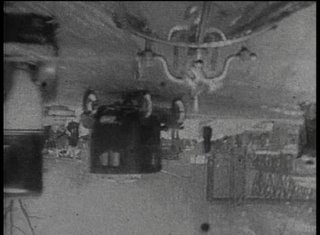
Dashes of N.Y.F.D. (film #1387 on Prelinger Archive). [Category: Industrial]
This collection of silent footage of the New York Fire Department during the 30s is a lot of fun to watch. The first section feature technical details of the fire alarm system. Then it gets really exciting, as we get to ride in the fire chief’s car, viewing its rapid journey through the streets from the perspective of a camera mounted on the dashboard. This is exciting footage, not just because of its high speed but because the streets are snow-covered, the car has to go up on the sidewalk periodically to get past traffic jams (watch out, pedestrians!), and the action goes inexplicably upside-down at one point. Then we get to see the firemen fight a five-alarm warehouse fire. This is all a very historically interesting look into firefighting practices of the period, as well as being as exciting as, well, watching a fire.Ratings: Camp/Humor Value: **. Weirdness: ****. Historical Interest: *****. Overall Rating: ****.
The Crazy Ray (film #45 in the Silents section of Movieflix). [Category: Hollywood]
Curious French 20s silent film about a nightwatchman on the Eiffel Tower who discovers all motioned stilled in Paris in the wee hours of one morning. People are still alive, but in a state of suspended animation and nothing moves. He eventually meets up with a group of rich playboy-types who arrive in an airplane. They have lots of fun looting the still world, until they get bored, and then things start to get unpleasant. They eventually discover a mad scientist who is responsible for the freezing of everything––he invented a ray that stops all motion. This ends up being less of a typical sci-fi adventure plot, and more a Twilight Zone-ish exploration of what people would do under these strange circumstances. Making this a great example of the science fiction movie in its infancy.Ratings: Camp/Humor Value: **. Weirdness: ***. Historical Interest: ****. Overall Rating: ***.
Charley Junior’s School Days (film #12 on National Archives). [Category: Educational]
Animated British film from the 50s explaining the educational reforms of the time. Charley’s son, who is still in heaven waiting to be born, has all kinds of questions about what sort of schools he’ll go to, questions that are answered by a patient heavenly nursemaid. This is all charmingly animated, especially the scene of various merchants bringing all kinds of goods to the newly-built schools. A fun way to learn about how England’s school system changed during the post-war period.Ratings: Camp/Humor Value: **. Weirdness: ***. Historical Interest: ****. Overall Rating: ****.
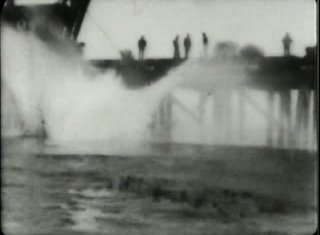
Building a Harbor at San Pedro (film #24 on America at Work, America at Leisure. Also, film #41 on Edison Film Archive. Also in the Historical section of Open Video Project). [Category: Early Film & TV]
A big steam-powered pulley on a pier picks up big rocks and throws them into the water. Lots of ‘em. Four minutes’ worth of ‘em. And the cameraman looks like he’s working up to a good case of seasickness. This sure gives you a good idea of a typical workday in 1901. A 1901 Edison film.Ratings: Camp/Humor Value: *. Weirdness: **. Historical Interest: ***. Overall Rating: **.
The Countryman and the Cinematograph (film #17 on The Movies Begin, Volume Two: The Eurpoean Pioneers (Kino Video, 1994)). [Category: Early Film & TV]
A bumpkin watches some short film clips (his first movies, obviously) and reacts predictably––dodging a train, etc. Too short to be of much interest, though. A 1901 R. W. Paul film.Ratings: Camp/Humor Value: **. Weirdness: ***. Historical Interest: ***. Overall Rating: **.
Avon (film #11 in The Modern 70s Woman section of TVParty). [Category: Commercial]
Fairly standard 70s commercial for Avon. This has some historical value as the customer in the ad has just gotten a job, and the Avon lady is selling her lipstick and jewelry so she can have a professional appearance. Too bad she won’t be home for further Avon calls. A brief blip from the 70s.Ratings: Camp/Humor Value: **. Weirdness: **. Historical Interest: ****. Overall Rating: ***.
Dr. Jekyll and Sister Hyde Trailer (film #76 in the Trailers section of Movieflix). [Category: Sleaze & Outsider]
Fairly standard trailer for the gender-bending Hammer flick Dr. Jekyll and Sister Hyde. This plays up the horror rather than the sex, so it’s not nearly as lurid as the title makes it sound. It actually looks somewhat classy, which makes it less interesting from an ephemera standpoint.Ratings: Camp/Humor Value: *. Weirdness: **. Historical Interest: ***. Overall Rating: **.
Charley’s March of Time (film #10 on National Archives). [Category: Public Service]
Charming British animated film from the 50s meant to explain the National Insurance Act. Charley, a sort of British Everybloke, complains about the cost of the new government insurance plan, so the narrator shows him what it was like in the bad old days before any government help for people in need. In fact, he goes way back to the beginning of life on Earth. Since this is way overdoing it, Charley eventually relents, just to stop the time travel. This is a cute film that makes its point well and provides a great historical snapshot of the history of British social services.Ratings: Camp/Humor Value: ***. Weirdness: ***. Historical Interest: ****. Overall Rating: ****.
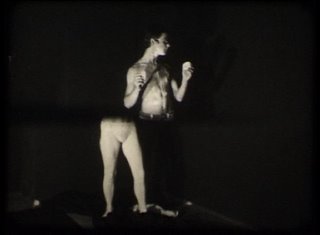
Above/Under (“Oben/Unten”) (film #11 on German Cinema). [Category: Outtakes & Obscurities]
Experimental German film featuring people dancing to techno/noise music. Bizarre camera angles and tricks are experimented with, resulting in a moderately strange, trippy experience, though nothing as disturbing as The Buckskin Kid. The music really carries this one, having a bit more structure and interest than most techno/noise stuff.Ratings: Camp/Humor Value: **. Weirdness: ****. Historical Interest: ****. Overall Rating: ****.
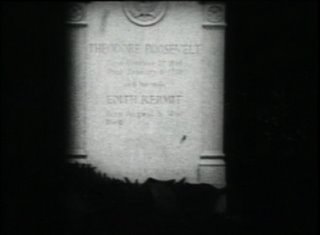
Close-Up of TR’s Grave, 1920 (film #6 on Theodore Roosevelt). [Category: News]
This is exactly what the title says: a close-up of Theodore Roosevelt’s grave that lasts about 11 seconds. No soundtrack, no movement, no nothin’. They might as well have just posted a still picture.Ratings: Camp/Humor Value: *. Weirdness: **. Historical Interest: **. Overall Rating: *.
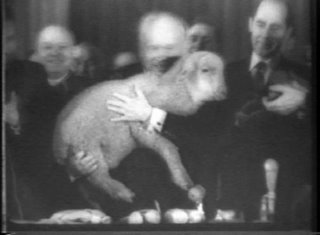
Anglo-US Amity: US, British Pledge United Front (film #60 on Universal Newsreels). [Category: Military & Propaganda]
Newsreel clip from 1961 featuring a dull story about talks between President Kennedy and British Prime Minister Harold McMillan. More interesting are the stories that follow it, which involve Russian dogs into space, Khruschchev being presented with a sheep at a Siberian agricultural festival, automatic pilots for NATO B-47s, a zoo workers’ strike, and a German women’s soccer tournament. These last two stories are narrated in a smarmy fashion reminiscent of Chevrolet Leader News. A lighter-hearted slice of the Cold War.Ratings: Camp/Humor Value: ***. Weirdness: ****. Historical Interest: ****. Overall Rating: ****.
Brief City (film #21 on National Archives). [Category: Industrial]
This film documents the building and architectural design of the 1951 Festival of Britain, a world’s-fair-like exhibition held in London during the austere post-war period. As such, there is a dark backdrop to the film, unlike the usual cheery optimism that marks most world’s fairs. You get a sense that the hopefulness is a defense against despair, though in a healthy sense. The film is also very British, with the narrator explaining that many of the design decisions were made specifically to appeal to the British people––this is also a change from the internationalism usually touted at such fairs. The design is fascinating, involving not grand vistas, but little hideaways and cul-de-sacs, secret places for individuals to discover and enjoy. I personally love that sort of design, so I found the film very enjoyable on that level. This is one of the most unusual world’s fair films I’ve ever seen. It’s definitely worth a look as a counterpoint to the usual World of Tomorrow type of stuff.Ratings: Camp/Humor Value: **. Weirdness: ****. Historical Interest: *****. Overall Rating: ****.
Combat Fatigue: Insomnia (in the Ephemeral section of Open Video Project. Also, film #356 on Prelinger Archive). [Category: Military & Propaganda]
This WWII vintage navy training film looks like it could have been made by Coronet, and not just because of the presence of Dick York. “Combat fatigue” was the term they used to use for posttraumatic stress disorder brought on by combat. Insomnia is a common symptom of PTSD, but here it’s treated like one of the teen “problems” found in Coronet social guidance films. Dick York is concerned about his buddy Buzz, who has a serious insomnia problem. Both sailors wear squeaky-clean uniforms and are stationed in a unit that looks like the worst combat it ever had to deal with was alcoholic fisticuffs. Actually, maybe not even that––these sailors’ main form of recreation seems to be watching Donald Duck cartoons. After having a trite conversation with Buzz about his lack of sleep problem, Dick finds he can’t get to sleep. Fortunately, help comes in the form of a disembodied voice who makes Dick’s and Buzz’s thoughts audible to the rest of us. Somehow, this helps Dick to stop worrying about what he can’t change and he falls quickly to sleep. Somehow these audible thoughts manage not to generate a peep of complaint from the other guys in the unit who are trying to get to sleep as well. Even the disembodied voice admits that Buzz’s problem is not so easily solved. So the voice sends Buzz a few bizarre visual hallucinations, and when that doesn’t seem to help for some odd reason, the voice does a guided relaxation exercise with Buzz. Buzz, knowing that he is outclassed here, finally feigns sleep to get the voice to go away. As it sounds, this is a kooky, campy film, complete with bouncy title music. It probably predates Coronet, but it could be shown in a Coronet film festival and be indistinguishable. Seeing the Coronet approach used in a military context makes it much more campy and bizarre than in the typical educational film, which, after all, was made for kids. And seeing Dick York play an adult sailor in a 1945 film makes you start to wonder just how old he was when he played all those teen roles for Coronet during the 50s (after seeing him in the shower scene, though, you’re not surprised that he was cast as a teen). This bizarre film is a must-see.Ratings: Camp/Humor Value: *****. Weirdness: *****. Historical Interest: *****. Overall Rating: *****.
Subscribe to:
Comments (Atom)
Better Reading
Better Reading . Teenager Harold Wilson has a problem—he can’t read for (expletive deleted). So he has to spend all his free time studying ...

-
The Best Made Plans. A 50s housewife solves all problems with Saran Wrap plastic film. Of course, all her problems are the kinds we all wa...
-
Better Reading . Teenager Harold Wilson has a problem—he can’t read for (expletive deleted). So he has to spend all his free time studying ...
-
Annie Oakley – Annie and the First Phone (film #15 in the Classic TV section of Movieflix ). [Category: Early Film & TV] This early-50s ...